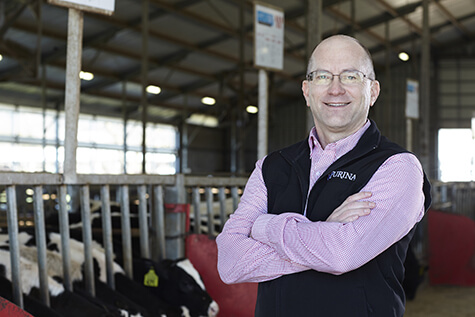
Transition Dairy Cow Nutrition: 3 Ways to Find Balance
Cow : Management
Cow : Transition Cow Nutrition
The transition period, 21 days before calving through 21 days post-fresh, is the most critical stage in a cow’s lactation. The ability to successfully navigate the transition period impacts peak milk production, reproductive efficiency and overall health and immunity.
Understanding specific transition cow nutrition needs gives you the opportunity to fully unlock milk production and profit potential. Focus on these three areas to maximize transition cow performance:
After calving, the amount of calcium available to a dairy cow is low compared to the amount needed for milk production. When blood calcium gets too low, fresh cow milk production and health can be at risk. The result? Clinical or subclinical hypocalcemia (milk fever).
A negative dietary cation-anion difference (DCAD) diet with full anion supplementation is an effective way to help return a transition dairy cow to normal blood calcium levels and influence the prevalence of both clinical and subclinical milk fever.3 With this strategy, urine pH is reduced to 5.5-6.0, with little variability between cows. Thus, urine pH can be used as an indicator of good ration management.
Adequate MP is vital during the transition period in dairy cows. Milk production, health and metabolic functions could suffer without proper supplementation.
Instead of ration crude protein level, focus on the numbers that help support the animal’s protein and amino acid needs. Understanding the rate and extent of protein digestibility helps predict how much MP is supplied to the fresh cow and therefore available for milk and component production, as well as other important metabolic functions.
Focus on management and nutrition to encourage intake during the transition period in dairy cows. Track the neutral detergent fiber (NDF) digestibility and indigestible NDF to precisely evaluate fiber value and potential energy contribution in the transition dairy cow diet. Starch digestibility is also important. Fresh cows need a certain amount of starch and fiber to manage glucose demand and stay healthy, so it is important to balance total tract drivers of glucose, including supplying adequate rumen available starch.
We often err on the side of caution and tame-down the pre-fresh ration to keep her on-feed. But with a little more attention, we can find a balance of digestible and indigestible fiber, starch, sugars, fat and protein sources to keep her on feed and increase peak milk production without excessive weight loss.
A better understanding of dairy cattle nutrition can help you start transition cows strong and maximize performance. Learn how to keep your transition dairy cows healthy during this critical time.
1 Commercial Feeding Study, Purina Animal Nutrition, 2004
Understanding specific transition cow nutrition needs gives you the opportunity to fully unlock milk production and profit potential. Focus on these three areas to maximize transition cow performance:
 1. Manage fresh cow calcium status
1. Manage fresh cow calcium status
After calving, the amount of calcium available to a dairy cow is low compared to the amount needed for milk production. When blood calcium gets too low, fresh cow milk production and health can be at risk. The result? Clinical or subclinical hypocalcemia (milk fever).A negative dietary cation-anion difference (DCAD) diet with full anion supplementation is an effective way to help return a transition dairy cow to normal blood calcium levels and influence the prevalence of both clinical and subclinical milk fever.3 With this strategy, urine pH is reduced to 5.5-6.0, with little variability between cows. Thus, urine pH can be used as an indicator of good ration management.
2. Support metabolizable protein (MP) needs
More than 70% of a cow’s MP can be used to support fetal growth during the last month of gestation. In addition, cows struggle to regain protein balance after calving when feed intake drops while protein requirements to support fresh cow milk production are increasing.Adequate MP is vital during the transition period in dairy cows. Milk production, health and metabolic functions could suffer without proper supplementation.
Instead of ration crude protein level, focus on the numbers that help support the animal’s protein and amino acid needs. Understanding the rate and extent of protein digestibility helps predict how much MP is supplied to the fresh cow and therefore available for milk and component production, as well as other important metabolic functions.
3. Minimize negative energy balance
During the transition period in dairy cows, dry matter intake declines while energy requirements increase to support milk production. The resulting negative energy balance can impact fresh cow milk production and potentially reproductive performance.1Focus on management and nutrition to encourage intake during the transition period in dairy cows. Track the neutral detergent fiber (NDF) digestibility and indigestible NDF to precisely evaluate fiber value and potential energy contribution in the transition dairy cow diet. Starch digestibility is also important. Fresh cows need a certain amount of starch and fiber to manage glucose demand and stay healthy, so it is important to balance total tract drivers of glucose, including supplying adequate rumen available starch
We often err on the side of caution and tame-down the pre-fresh ration to keep her on-feed. But with a little more attention, we can find a balance of digestible and indigestible fiber, starch, sugars, fat and protein sources to keep her on feed and increase peak milk production without excessive weight loss.
A better understanding of dairy cattle nutrition can help you start transition cows strong and maximize performance. Learn how to keep your transition dairy cows healthy during this critical time.
1 Commercial Feeding Study, Purina Animal Nutrition, 2004



